Abstract
OBJECTIVE: To review the available English literature that examines the biology of leiomyoma uteri in African-American women and other ethnic groups. Factors that influence the growth and development of leiomyomas are examined to understand the basis for larger myomas in African-American women. DESIGN: Literature review of 176 articles regarding the pathobiology of leiomyoma in various ethnic groups. RESULTS: The initiating factor(s) associated with the transformation of a normal myometrial cell into a leiomyoma cell remain(s) to be determined. Epidemiological studies have confirmed that different ethnic groups develop leiomyomas. However, African-American ethnicity is a risk factor for the development of leiomyomas. Studies have examined diet, genetics, hormonal, growth, enzymatic and molecular determinants of myoma biology, with critical advances in some of these areas. The best radiological tools to identify and monitor leiomyomas are ultrasonography and/or magnetic resonance imaging. Evidence supports progesterone and growth factors (e.g., transforming growth factor-B), have significant impact on the development of leiomyomas. CONCLUSIONS: Early monitoring and intervention should become standard for African-American women who are at greater risk for developing leiomyomas. There are plausible biological mechanisms that explain the predisposition for developing larger leiomyomas in African-American women as compared with other ethnic groups.
Full text
PDF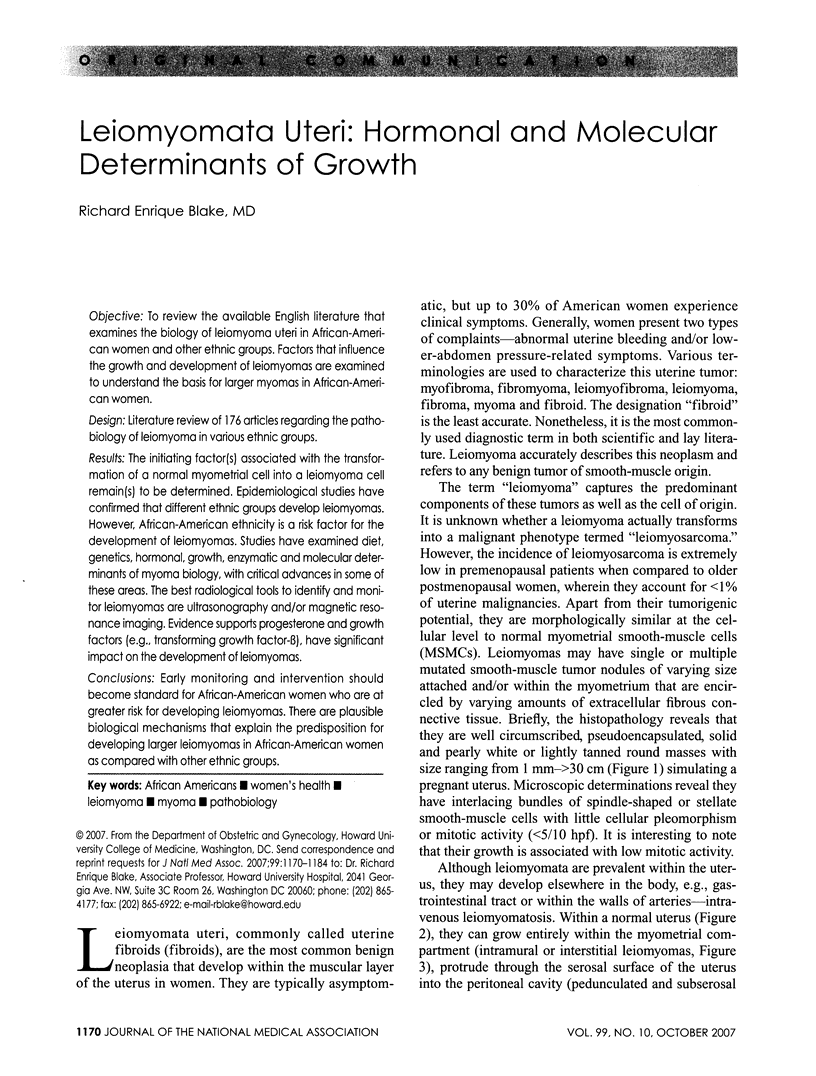
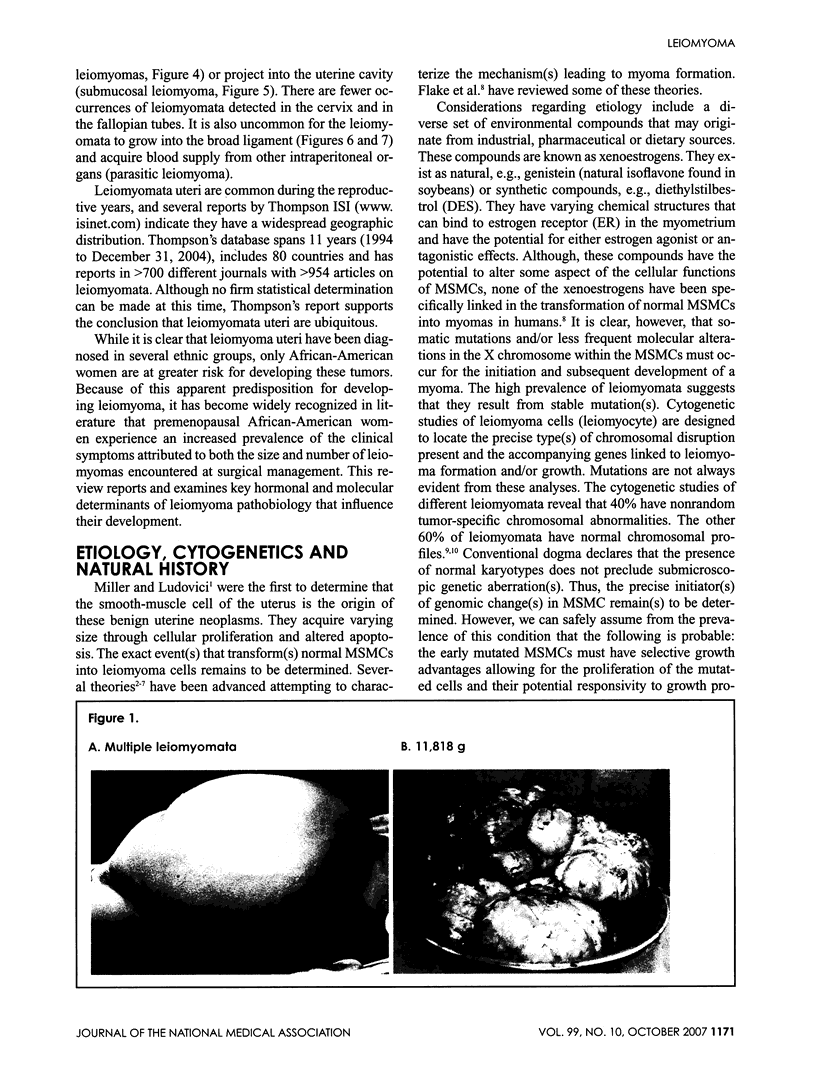
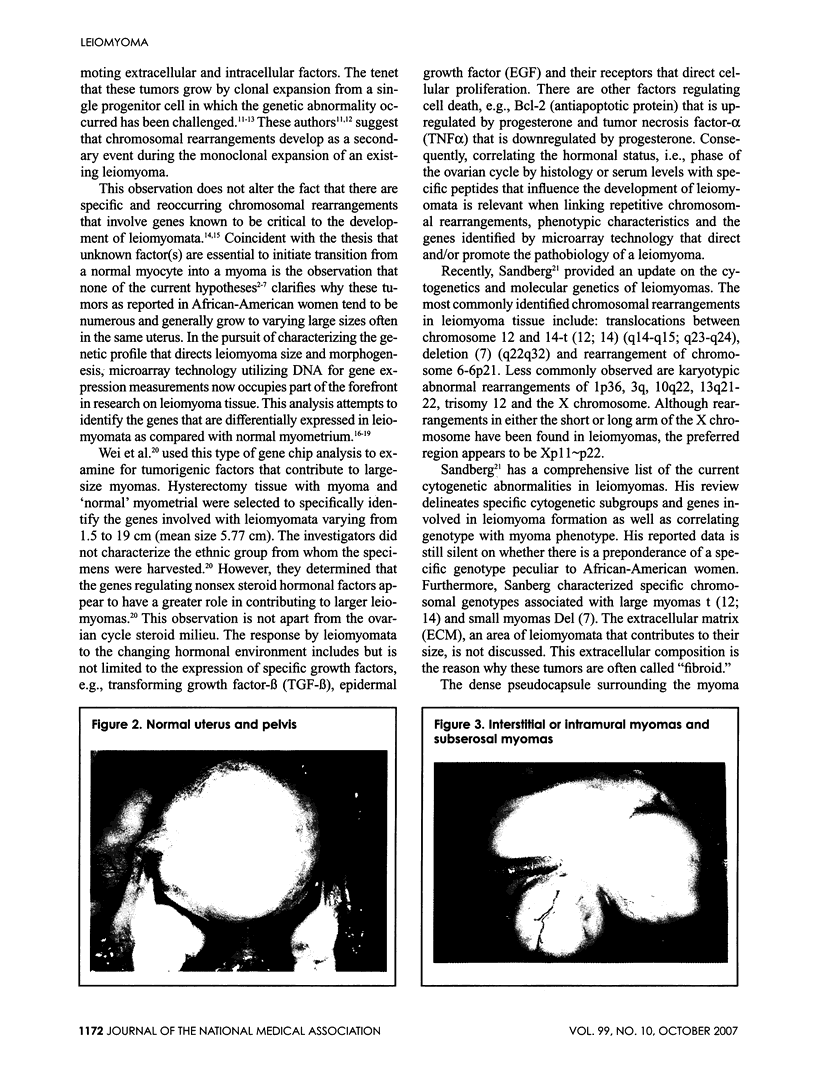
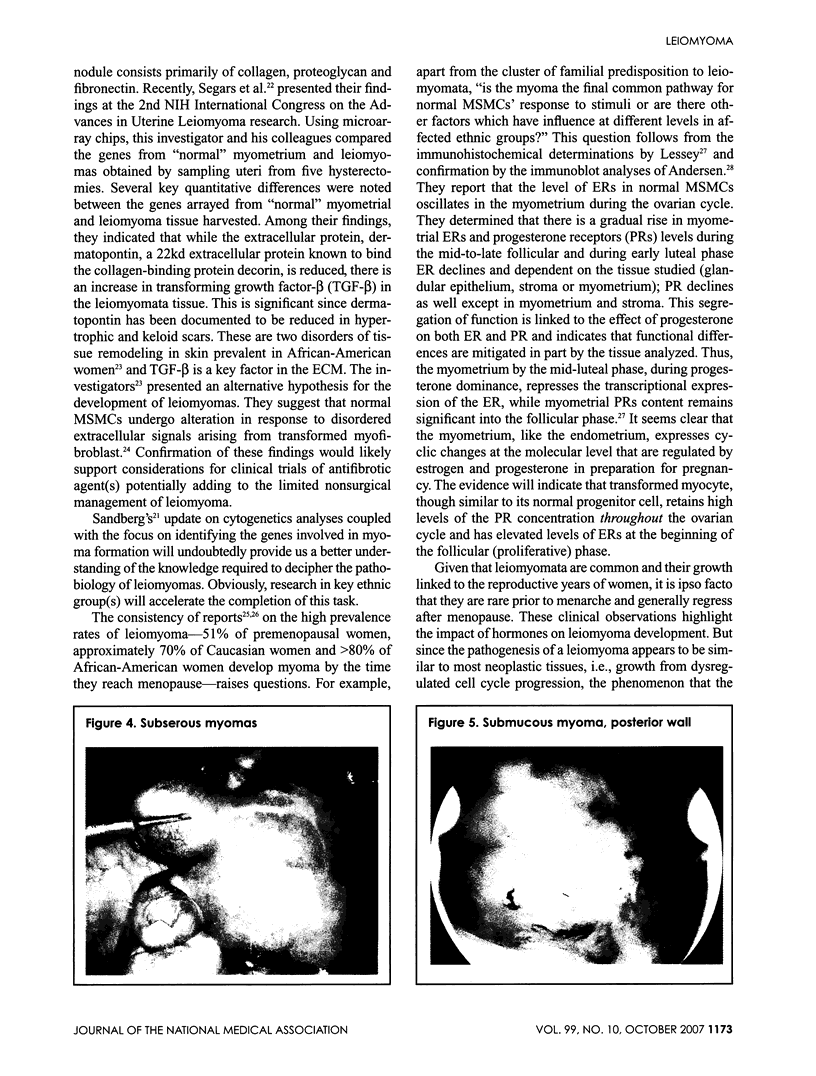
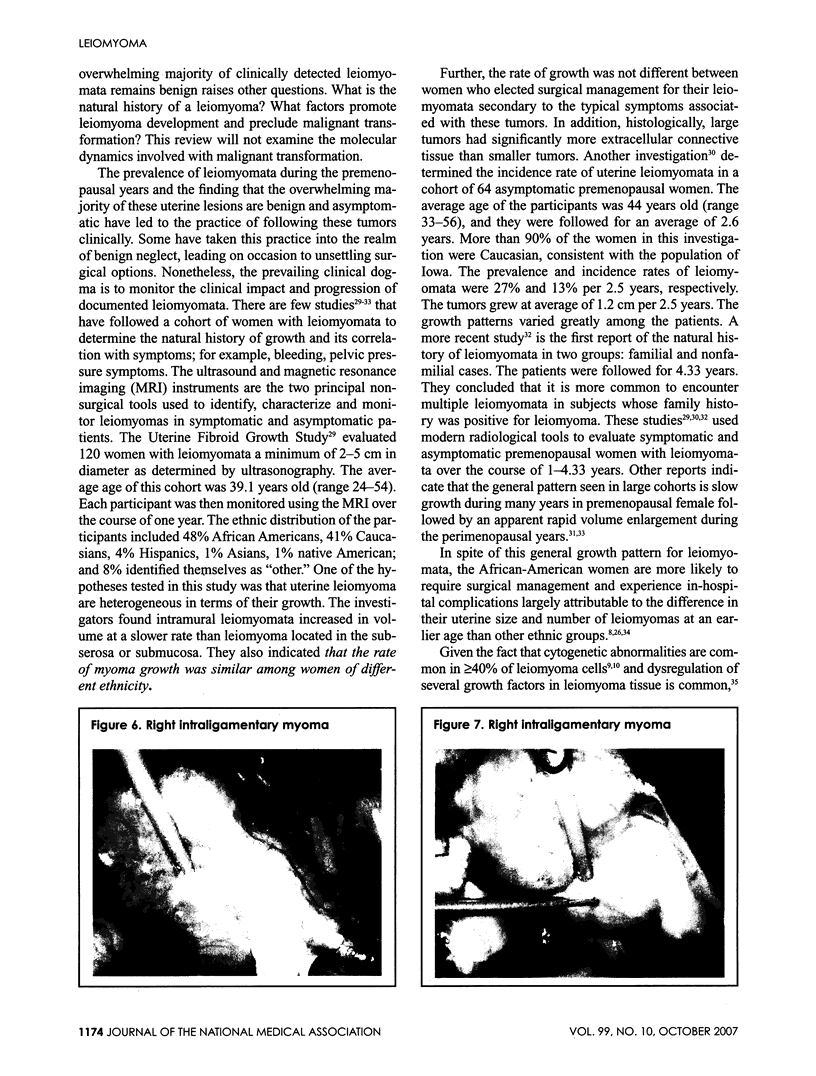
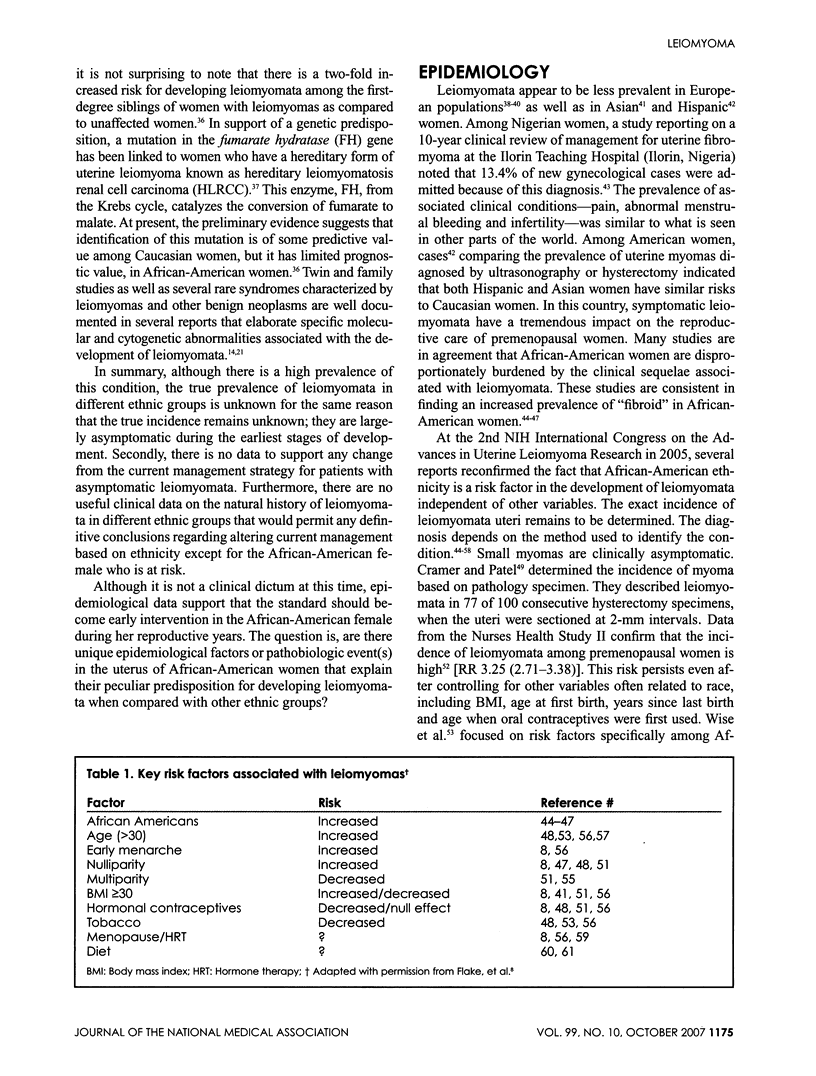
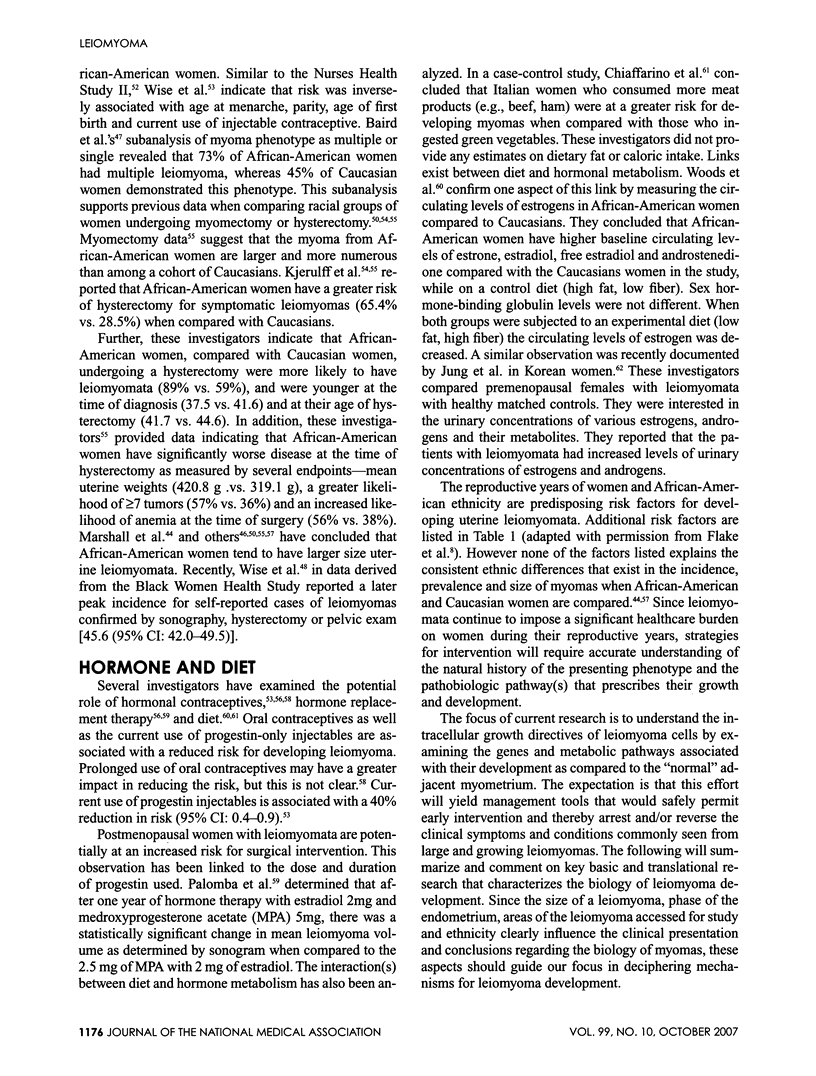
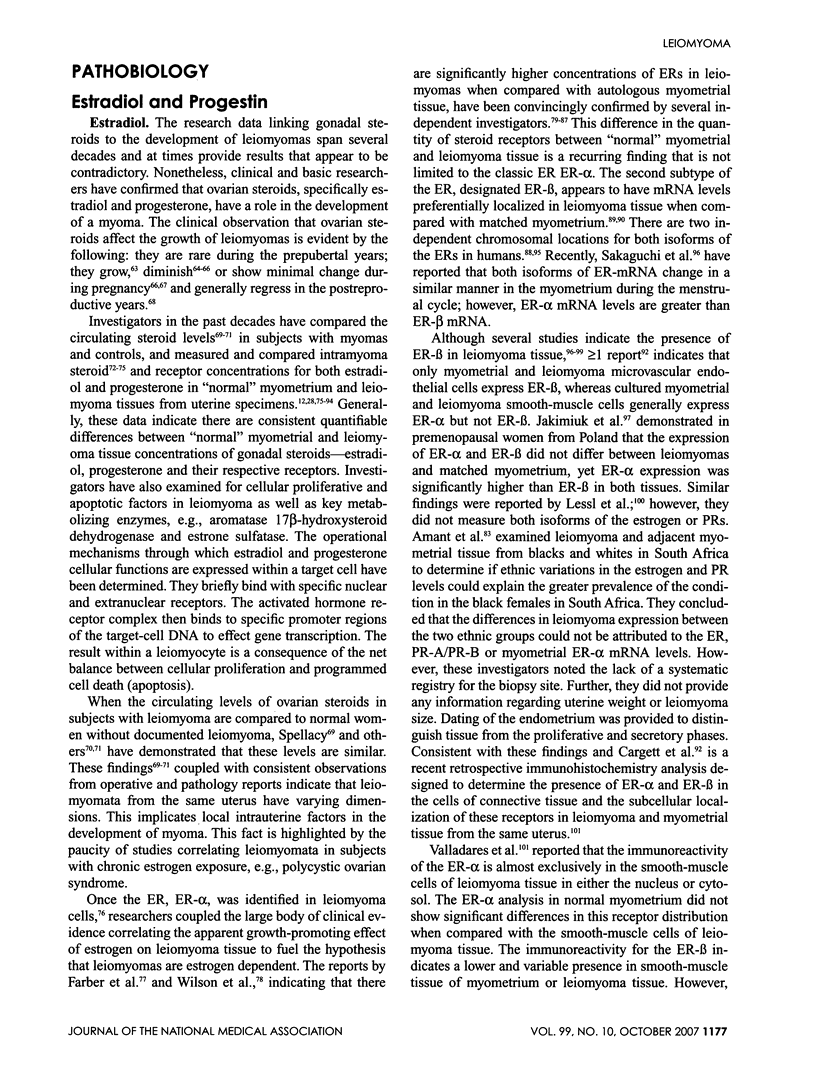
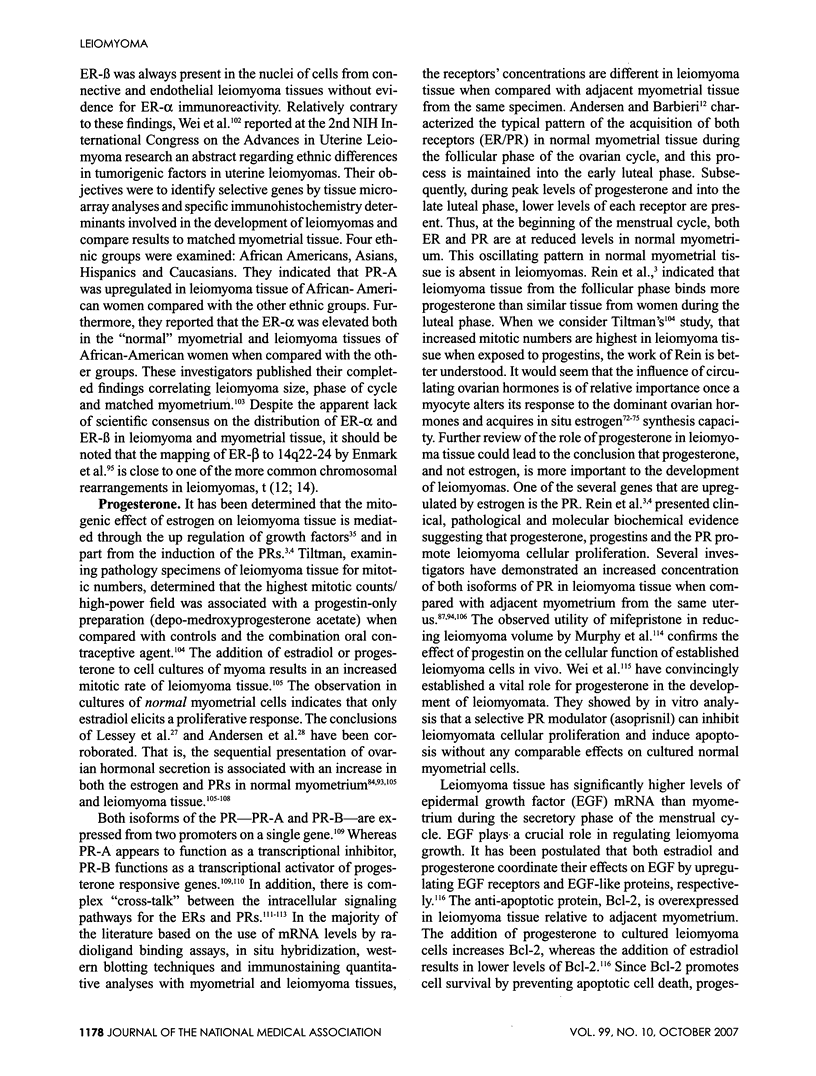
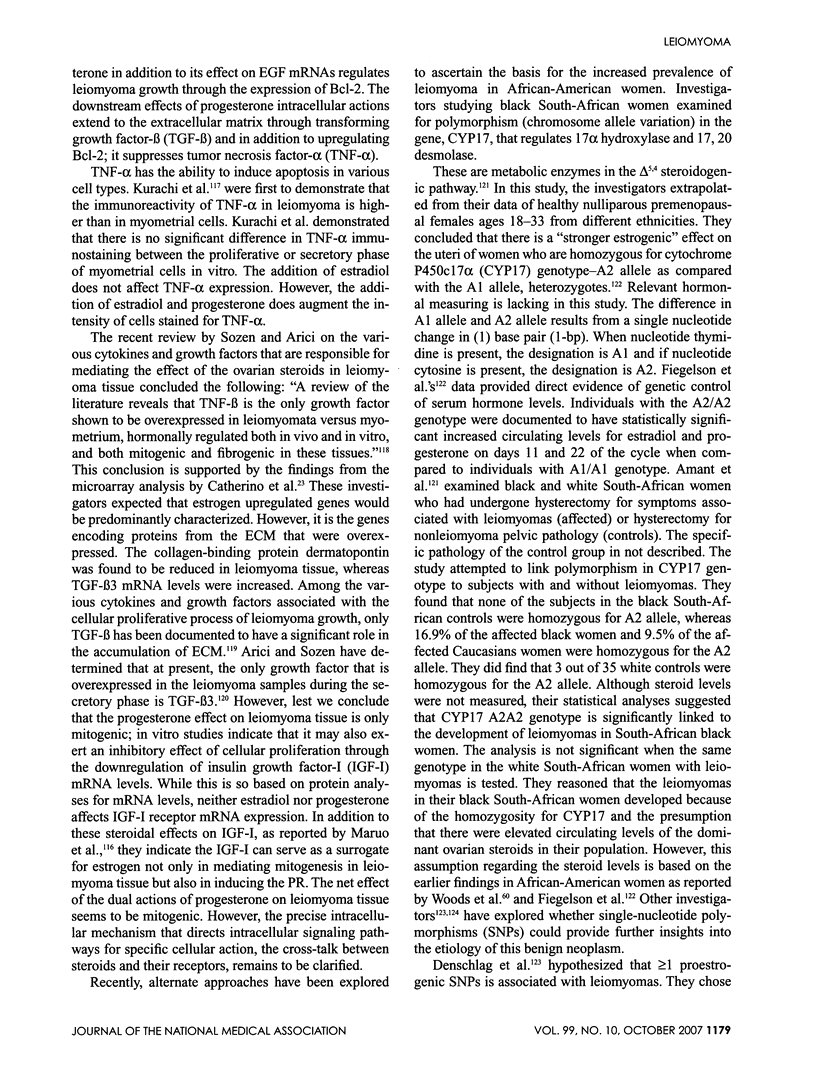
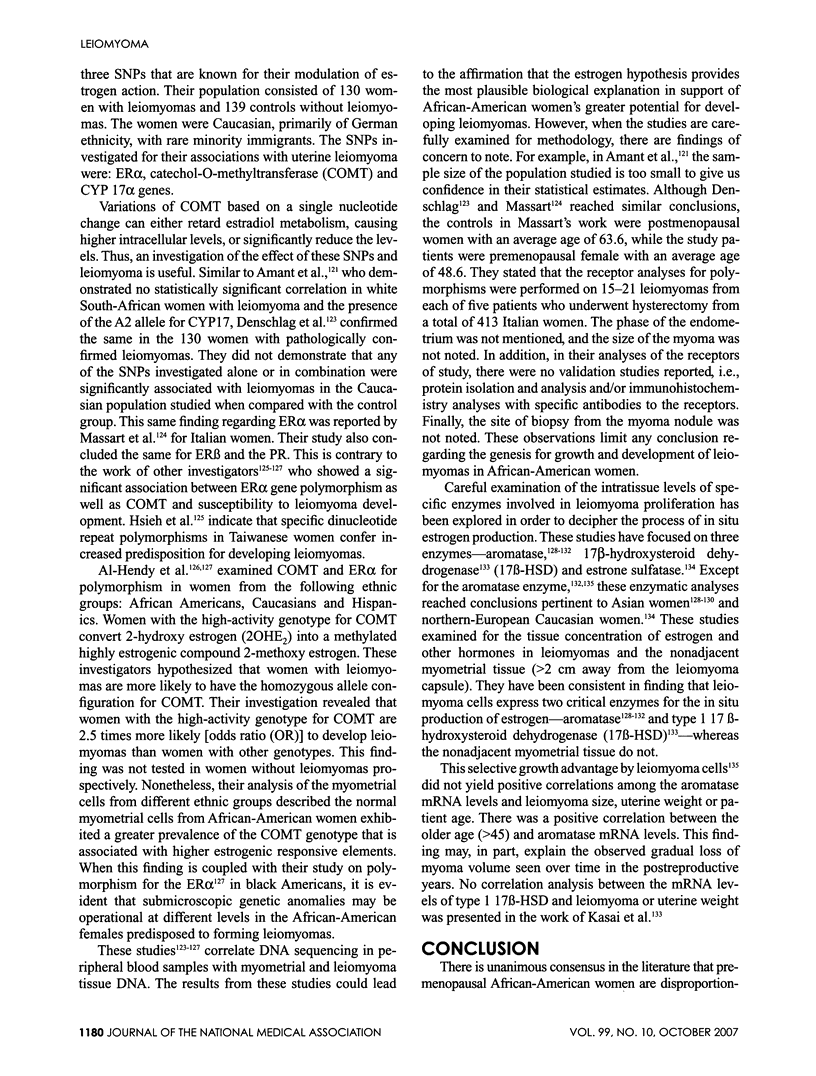
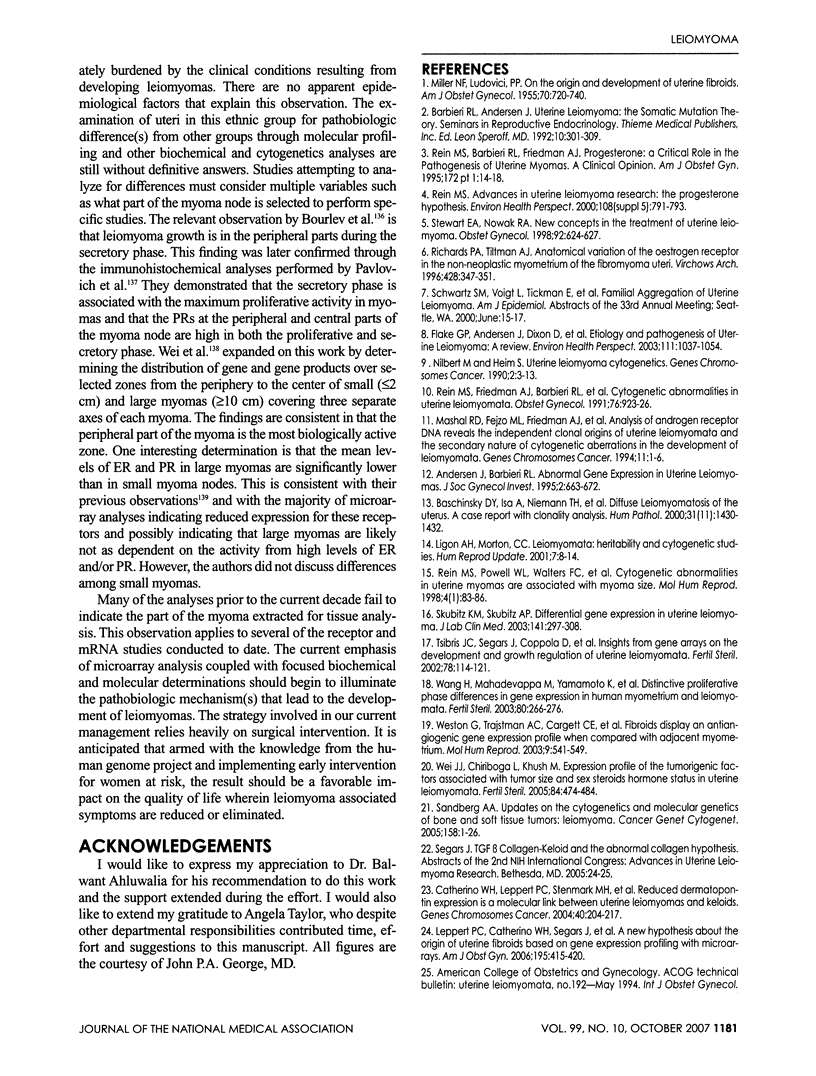
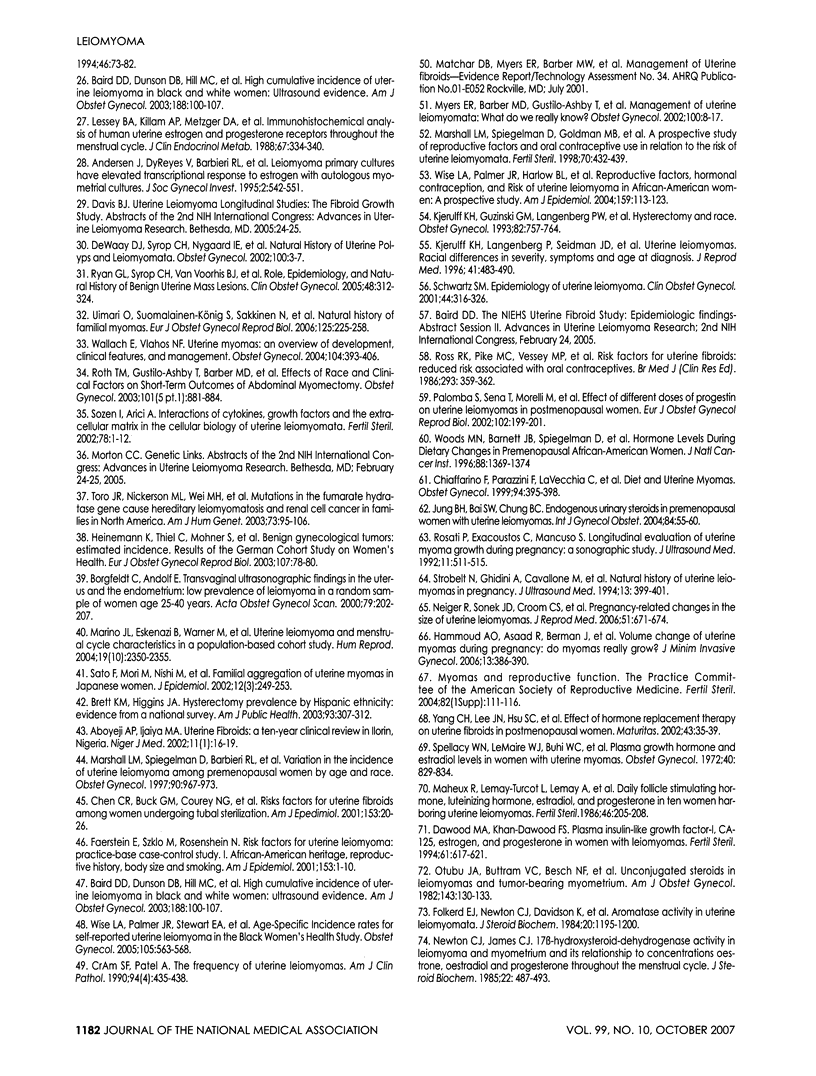
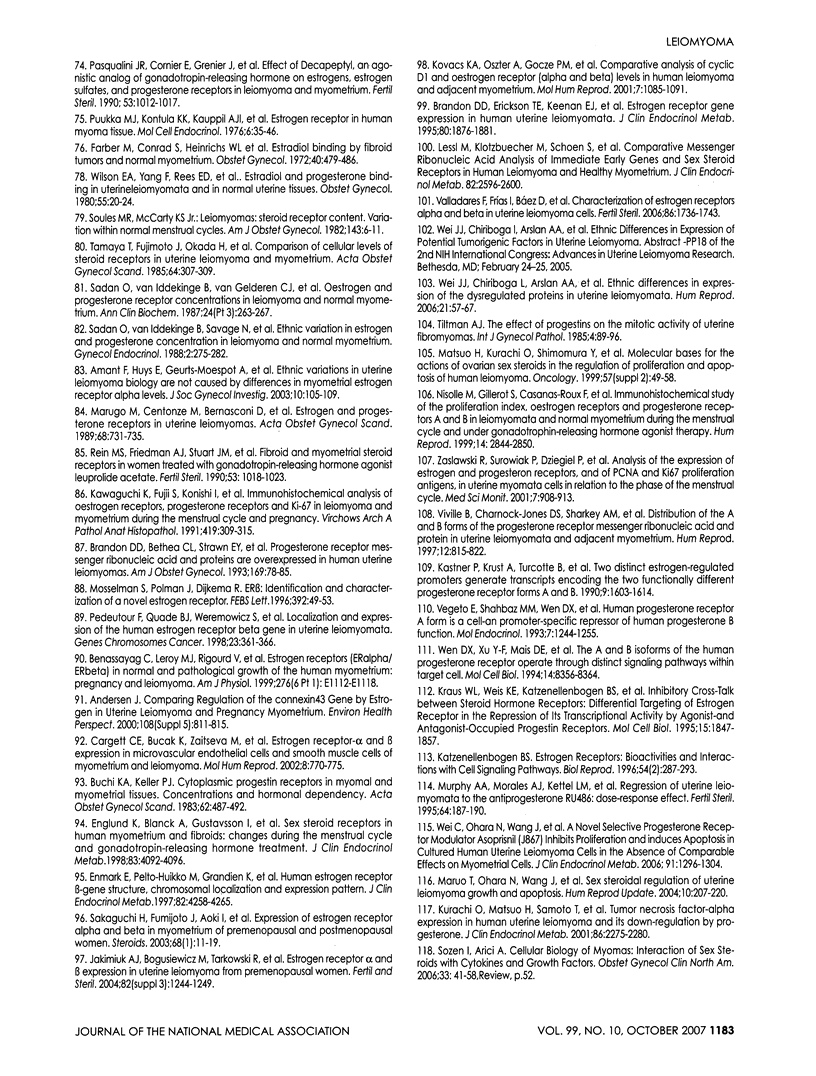
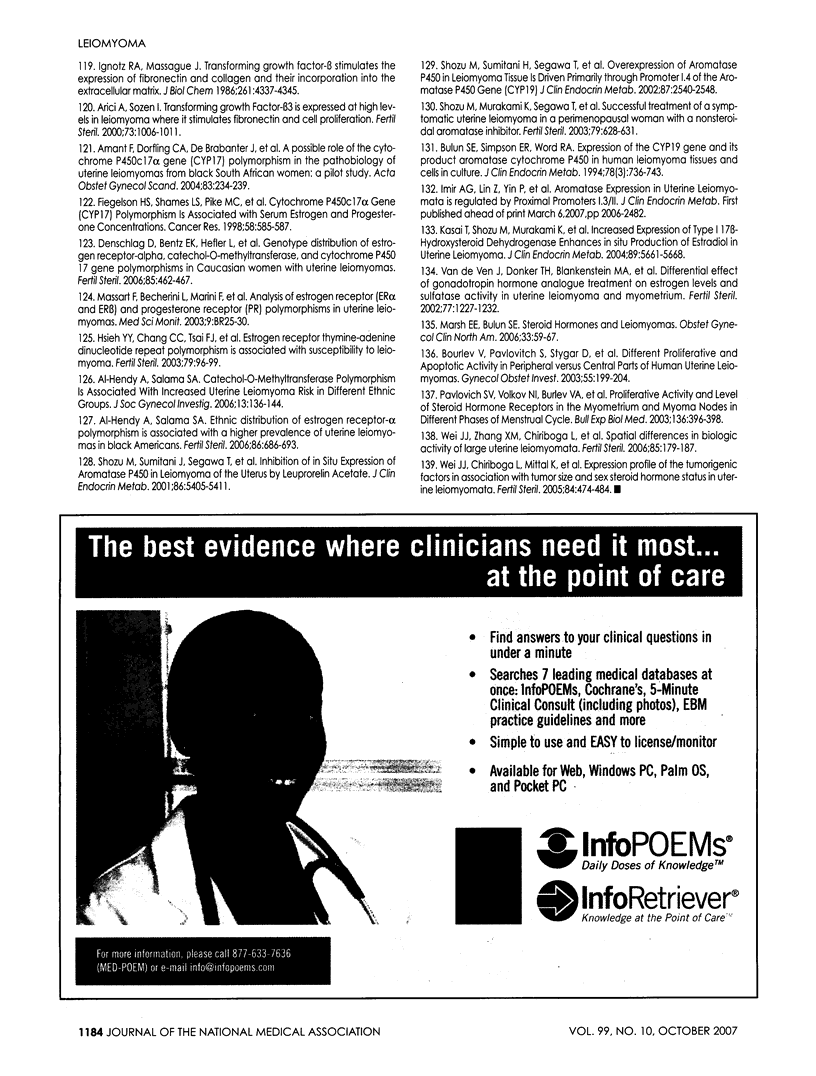
Images in this article
Selected References
These references are in PubMed. This may not be the complete list of references from this article.
- Aboyeji A. P., Ijaiya M. A. Uterine fibroids: a ten-year clinical review in Ilorin, Nigeria. Niger J Med. 2002 Jan-Mar;11(1):16–19. [PubMed] [Google Scholar]
- Al-Hendy Ayman, Salama Salama A. Catechol-O-methyltransferase polymorphism is associated with increased uterine leiomyoma risk in different ethnic groups. J Soc Gynecol Investig. 2006 Feb;13(2):136–144. doi: 10.1016/j.jsgi.2005.10.007. [DOI] [PubMed] [Google Scholar]
- Al-Hendy Ayman, Salama Salama A. Ethnic distribution of estrogen receptor-alpha polymorphism is associated with a higher prevalence of uterine leiomyomas in black Americans. Fertil Steril. 2006 Jul 24;86(3):686–693. doi: 10.1016/j.fertnstert.2006.01.052. [DOI] [PubMed] [Google Scholar]
- Amant Frédéric, Dorfling Cecilia M., de Brabanter Jos, Vandewalle Joos, Vergote Ignace, Lindeque B. G., van Rensburg Elizabeth J. A possible role of the cytochrome P450c17alpha gene (CYP17) polymorphism in the pathobiology of uterine leiomyomas from black South African women: a pilot study. Acta Obstet Gynecol Scand. 2004 Mar;83(3):234–239. [PubMed] [Google Scholar]
- Amant Frédéric, Huys Erik, Geurts-Moespot Anneke, Lindeque B. G., Vergote Ignace, Sweep Fred, Schoenmakers Eric F. P. M. Ethnic variations in uterine leiomyoma biology are not caused by differences in myometrial estrogen receptor alpha levels. J Soc Gynecol Investig. 2003 Feb;10(2):105–109. doi: 10.1016/s1071-5576(02)00253-8. [DOI] [PubMed] [Google Scholar]
- Andersen J., Barbieri R. L. Abnormal gene expression in uterine leiomyomas. J Soc Gynecol Investig. 1995 Sep-Oct;2(5):663–672. doi: 10.1016/1071-5576(95)00021-6. [DOI] [PubMed] [Google Scholar]
- Andersen J. Comparing regulation of the connexin43 gene by estrogen in uterine leiomyoma and pregnancy myometrium. Environ Health Perspect. 2000 Oct;108 (Suppl 5):811–815. [PubMed] [Google Scholar]
- Andersen J., DyReyes V. M., Barbieri R. L., Coachman D. M., Miksicek R. J. Leiomyoma primary cultures have elevated transcriptional response to estrogen compared with autologous myometrial cultures. J Soc Gynecol Investig. 1995 May-Jun;2(3):542–551. doi: 10.1016/1071-5576(94)00053-4. [DOI] [PubMed] [Google Scholar]
- Arici A., Sozen I. Transforming growth factor-beta3 is expressed at high levels in leiomyoma where it stimulates fibronectin expression and cell proliferation. Fertil Steril. 2000 May;73(5):1006–1011. doi: 10.1016/s0015-0282(00)00418-0. [DOI] [PubMed] [Google Scholar]
- Baird Donna Day, Dunson David B., Hill Michael C., Cousins Deborah, Schectman Joel M. High cumulative incidence of uterine leiomyoma in black and white women: ultrasound evidence. Am J Obstet Gynecol. 2003 Jan;188(1):100–107. doi: 10.1067/mob.2003.99. [DOI] [PubMed] [Google Scholar]
- Baird Donna Day, Dunson David B., Hill Michael C., Cousins Deborah, Schectman Joel M. High cumulative incidence of uterine leiomyoma in black and white women: ultrasound evidence. Am J Obstet Gynecol. 2003 Jan;188(1):100–107. doi: 10.1067/mob.2003.99. [DOI] [PubMed] [Google Scholar]
- Baschinsky D. Y., Isa A., Niemann T. H., Prior T. W., Lucas J. G., Frankel W. L. Diffuse leiomyomatosis of the uterus: a case report with clonality analysis. Hum Pathol. 2000 Nov;31(11):1429–1432. [PubMed] [Google Scholar]
- Borgfeldt C., Andolf E. Transvaginal ultrasonographic findings in the uterus and the endometrium: low prevalence of leiomyoma in a random sample of women age 25-40 years. Acta Obstet Gynecol Scand. 2000 Mar;79(3):202–207. [PubMed] [Google Scholar]
- Bourlev Vladimir, Pavlovitch Stanislav, Stygar Denis, Volkov Nikolai, Lindblom Bo, Olovsson Matts. Different proliferative and apoptotic activity in peripheral versus central parts of human uterine leiomyomas. Gynecol Obstet Invest. 2003;55(4):199–204. doi: 10.1159/000072074. [DOI] [PubMed] [Google Scholar]
- Brandon D. D., Bethea C. L., Strawn E. Y., Novy M. J., Burry K. A., Harrington M. S., Erickson T. E., Warner C., Keenan E. J., Clinton G. M. Progesterone receptor messenger ribonucleic acid and protein are overexpressed in human uterine leiomyomas. Am J Obstet Gynecol. 1993 Jul;169(1):78–85. doi: 10.1016/0002-9378(93)90135-6. [DOI] [PubMed] [Google Scholar]
- Brandon D. D., Erickson T. E., Keenan E. J., Strawn E. Y., Novy M. J., Burry K. A., Warner C., Clinton G. M. Estrogen receptor gene expression in human uterine leiomyomata. J Clin Endocrinol Metab. 1995 Jun;80(6):1876–1881. doi: 10.1210/jcem.80.6.7775635. [DOI] [PubMed] [Google Scholar]
- Brett Kate M., Higgins Jenny A. Hysterectomy prevalence by Hispanic ethnicity: evidence from a national survey. Am J Public Health. 2003 Feb;93(2):307–312. doi: 10.2105/ajph.93.2.307. [DOI] [PMC free article] [PubMed] [Google Scholar]
- Bulun S. E., Simpson E. R., Word R. A. Expression of the CYP19 gene and its product aromatase cytochrome P450 in human uterine leiomyoma tissues and cells in culture. J Clin Endocrinol Metab. 1994 Mar;78(3):736–743. doi: 10.1210/jcem.78.3.8126151. [DOI] [PubMed] [Google Scholar]
- Büchi K. A., Keller P. J. Cytoplasmic progestin receptors in myomal and myometrial tissues. Concentrations and hormonal dependency. Acta Obstet Gynecol Scand. 1983;62(5):487–492. doi: 10.3109/00016348309154224. [DOI] [PubMed] [Google Scholar]
- Catherino William H., Leppert Phyllis C., Stenmark Matthew H., Payson Mark, Potlog-Nahari Clariss, Nieman Lynnette K., Segars James H. Reduced dermatopontin expression is a molecular link between uterine leiomyomas and keloids. Genes Chromosomes Cancer. 2004 Jul;40(3):204–217. doi: 10.1002/gcc.20035. [DOI] [PMC free article] [PubMed] [Google Scholar]
- Chen C. R., Buck G. M., Courey N. G., Perez K. M., Wactawski-Wende J. Risk factors for uterine fibroids among women undergoing tubal sterilization. Am J Epidemiol. 2001 Jan 1;153(1):20–26. doi: 10.1093/aje/153.1.20. [DOI] [PubMed] [Google Scholar]
- Chen Wei, Ohara Noriyuki, Wang Jiayin, Xu Qin, Liu Jin, Morikawa Akira, Sasaki Hiroko, Yoshida Shigeki, Demanno Deborah A., Chwalisz Kristof. A novel selective progesterone receptor modulator asoprisnil (J867) inhibits proliferation and induces apoptosis in cultured human uterine leiomyoma cells in the absence of comparable effects on myometrial cells. J Clin Endocrinol Metab. 2006 Feb 7;91(4):1296–1304. doi: 10.1210/jc.2005-2379. [DOI] [PubMed] [Google Scholar]
- Chiaffarino F., Parazzini F., La Vecchia C., Chatenoud L., Di Cintio E., Marsico S. Diet and uterine myomas. Obstet Gynecol. 1999 Sep;94(3):395–398. doi: 10.1016/s0029-7844(99)00305-1. [DOI] [PubMed] [Google Scholar]
- Cramer S. F., Patel A. The frequency of uterine leiomyomas. Am J Clin Pathol. 1990 Oct;94(4):435–438. doi: 10.1093/ajcp/94.4.435. [DOI] [PubMed] [Google Scholar]
- Dawood M. Y., Khan-Dawood F. S. Plasma insulin-like growth factor-I, CA-125, estrogen, and progesterone in women with leiomyomas. Fertil Steril. 1994 Apr;61(4):617–621. doi: 10.1016/s0015-0282(16)56635-7. [DOI] [PubMed] [Google Scholar]
- DeWaay Deborah J., Syrop Craig H., Nygaard Ingrid E., Davis William A., Van Voorhis Bradley J. Natural history of uterine polyps and leiomyomata. Obstet Gynecol. 2002 Jul;100(1):3–7. doi: 10.1016/s0029-7844(02)02007-0. [DOI] [PubMed] [Google Scholar]
- Denschlag Dominik, Bentz Eva-Katrin, Hefler Lukas, Pietrowski Detlef, Zeillinger Robert, Tempfer Clemens, Tong Dan. Genotype distribution of estrogen receptor-alpha, catechol-O-methyltransferase, and cytochrome P450 17 gene polymorphisms in Caucasian women with uterine leiomyomas. Fertil Steril. 2006 Feb;85(2):462–467. doi: 10.1016/j.fertnstert.2005.07.1308. [DOI] [PubMed] [Google Scholar]
- Enmark E., Pelto-Huikko M., Grandien K., Lagercrantz S., Lagercrantz J., Fried G., Nordenskjöld M., Gustafsson J. A. Human estrogen receptor beta-gene structure, chromosomal localization, and expression pattern. J Clin Endocrinol Metab. 1997 Dec;82(12):4258–4265. doi: 10.1210/jcem.82.12.4470. [DOI] [PubMed] [Google Scholar]
- Faerstein E., Szklo M., Rosenshein N. Risk factors for uterine leiomyoma: a practice-based case-control study. I. African-American heritage, reproductive history, body size, and smoking. Am J Epidemiol. 2001 Jan 1;153(1):1–10. doi: 10.1093/aje/153.1.1. [DOI] [PubMed] [Google Scholar]
- Farber M., Conrad S., Heinrichs W. L., Herrmann W. L. Estradiol binding by fibroid tumors and normal myometrium. Obstet Gynecol. 1972 Oct;40(4):479–486. [PubMed] [Google Scholar]
- Feigelson H. S., Shames L. S., Pike M. C., Coetzee G. A., Stanczyk F. Z., Henderson B. E. Cytochrome P450c17alpha gene (CYP17) polymorphism is associated with serum estrogen and progesterone concentrations. Cancer Res. 1998 Feb 15;58(4):585–587. [PubMed] [Google Scholar]
- Flake Gordon P., Andersen Janet, Dixon Darlene. Etiology and pathogenesis of uterine leiomyomas: a review. Environ Health Perspect. 2003 Jun;111(8):1037–1054. doi: 10.1289/ehp.5787. [DOI] [PMC free article] [PubMed] [Google Scholar]
- Folkerd E. J., Newton C. J., Davidson K., Anderson M. C., James V. H. Aromatase activity in uterine leiomyomata. J Steroid Biochem. 1984 May;20(5):1195–1200. doi: 10.1016/0022-4731(84)90366-2. [DOI] [PubMed] [Google Scholar]
- Gargett Caroline E., Bucak Kristina, Zaitseva Marina, Chu Simon, Taylor Nancy, Fuller Peter J., Rogers Peter A. W. Estrogen receptor-alpha and -beta expression in microvascular endothelial cells and smooth muscle cells of myometrium and leiomyoma. Mol Hum Reprod. 2002 Aug;8(8):770–775. doi: 10.1093/molehr/8.8.770. [DOI] [PubMed] [Google Scholar]
- Hammoud Ahmad O., Asaad Radwan, Berman Jay, Treadwell Marjorie C., Blackwell Sean, Diamond Michael P. Volume change of uterine myomas during pregnancy: do myomas really grow? J Minim Invasive Gynecol. 2006 Sep-Oct;13(5):386–390. doi: 10.1016/j.jmig.2006.04.003. [DOI] [PubMed] [Google Scholar]
- Heinemann Klaas, Thiel Christine, Möhner Sabine, Lewis Michael A., Raff Thorsten, Kühl-Habich Dörthe, Heinemann Lothar A. J., German Cohort Study on Women's Health Benign gynecological tumors: estimated incidence. Results of the German Cohort Study on Women's Health. Eur J Obstet Gynecol Reprod Biol. 2003 Mar 26;107(1):78–80. doi: 10.1016/s0301-2115(02)00308-1. [DOI] [PubMed] [Google Scholar]
- Hsieh Yao-Yuan, Chang Chi-Chen, Tsai Fuu-Jen, Tsai Horng-Der, Yeh Lian-Shun, Lin Cheng-Chieh, Tsai Chang-Hai. Estrogen receptor thymine-adenine dinucleotide repeat polymorphism is associated with susceptibility to leiomyoma. Fertil Steril. 2003 Jan;79(1):96–99. doi: 10.1016/s0015-0282(02)04563-6. [DOI] [PubMed] [Google Scholar]
- Ignotz R. A., Massagué J. Transforming growth factor-beta stimulates the expression of fibronectin and collagen and their incorporation into the extracellular matrix. J Biol Chem. 1986 Mar 25;261(9):4337–4345. [PubMed] [Google Scholar]
- Jakimiuk Artur J., Bogusiewicz Michal, Tarkowski Rafal, Dziduch Piotr, Adamiak Aneta, Wróbel Andrzej, Haczyński Józef, Magoffin Denis A., Jakowicki Jerzy A. Estrogen receptor alpha and beta expression in uterine leiomyomas from premenopausal women. Fertil Steril. 2004 Oct;82 (Suppl 3):1244–1249. doi: 10.1016/j.fertnstert.2004.02.130. [DOI] [PubMed] [Google Scholar]
- Jung B. H., Bai S. W., Chung B. C. Endogenous urinary steroids in premenopausal women with uterine leiomyomas. Int J Gynaecol Obstet. 2004 Jan;84(1):55–60. doi: 10.1016/s0020-7292(03)00336-9. [DOI] [PubMed] [Google Scholar]
- Kasai Tadayuki, Shozu Makio, Murakami Kouichi, Segawa Tomoya, Shinohara Kazunori, Nomura Kazuhito, Inoue Masaki. Increased expression of type I 17beta-hydroxysteroid dehydrogenase enhances in situ production of estradiol in uterine leiomyoma. J Clin Endocrinol Metab. 2004 Nov;89(11):5661–5668. doi: 10.1210/jc.2003-032085. [DOI] [PubMed] [Google Scholar]
- Kastner P., Krust A., Turcotte B., Stropp U., Tora L., Gronemeyer H., Chambon P. Two distinct estrogen-regulated promoters generate transcripts encoding the two functionally different human progesterone receptor forms A and B. EMBO J. 1990 May;9(5):1603–1614. doi: 10.1002/j.1460-2075.1990.tb08280.x. [DOI] [PMC free article] [PubMed] [Google Scholar]
- Katzenellenbogen B. S. Estrogen receptors: bioactivities and interactions with cell signaling pathways. Biol Reprod. 1996 Feb;54(2):287–293. doi: 10.1095/biolreprod54.2.287. [DOI] [PubMed] [Google Scholar]
- Kawaguchi K., Fujii S., Konishi I., Iwai T., Nanbu Y., Nonogaki H., Ishikawa Y., Mori T. Immunohistochemical analysis of oestrogen receptors, progesterone receptors and Ki-67 in leiomyoma and myometrium during the menstrual cycle and pregnancy. Virchows Arch A Pathol Anat Histopathol. 1991;419(4):309–315. doi: 10.1007/BF01606522. [DOI] [PubMed] [Google Scholar]
- Kjerulff K. H., Guzinski G. M., Langenberg P. W., Stolley P. D., Moye N. E., Kazandjian V. A. Hysterectomy and race. Obstet Gynecol. 1993 Nov;82(5):757–764. [PubMed] [Google Scholar]
- Kjerulff K. H., Langenberg P., Seidman J. D., Stolley P. D., Guzinski G. M. Uterine leiomyomas. Racial differences in severity, symptoms and age at diagnosis. J Reprod Med. 1996 Jul;41(7):483–490. [PubMed] [Google Scholar]
- Kovács K. A., Oszter A., Göcze P. M., Környei J. L., Szabó I. Comparative analysis of cyclin D1 and oestrogen receptor (alpha and beta) levels in human leiomyoma and adjacent myometrium. Mol Hum Reprod. 2001 Nov;7(11):1085–1091. doi: 10.1093/molehr/7.11.1085. [DOI] [PubMed] [Google Scholar]
- Kraus W. L., Weis K. E., Katzenellenbogen B. S. Inhibitory cross-talk between steroid hormone receptors: differential targeting of estrogen receptor in the repression of its transcriptional activity by agonist- and antagonist-occupied progestin receptors. Mol Cell Biol. 1995 Apr;15(4):1847–1857. doi: 10.1128/mcb.15.4.1847. [DOI] [PMC free article] [PubMed] [Google Scholar]
- Kurachi O., Matsuo H., Samoto T., Maruo T. Tumor necrosis factor-alpha expression in human uterine leiomyoma and its down-regulation by progesterone. J Clin Endocrinol Metab. 2001 May;86(5):2275–2280. doi: 10.1210/jcem.86.5.7469. [DOI] [PubMed] [Google Scholar]
- Leppert Phyllis C., Catherino William H., Segars James H. A new hypothesis about the origin of uterine fibroids based on gene expression profiling with microarrays. Am J Obstet Gynecol. 2006 Apr 25;195(2):415–420. doi: 10.1016/j.ajog.2005.12.059. [DOI] [PMC free article] [PubMed] [Google Scholar]
- Lessey B. A., Killam A. P., Metzger D. A., Haney A. F., Greene G. L., McCarty K. S., Jr Immunohistochemical analysis of human uterine estrogen and progesterone receptors throughout the menstrual cycle. J Clin Endocrinol Metab. 1988 Aug;67(2):334–340. doi: 10.1210/jcem-67-2-334. [DOI] [PubMed] [Google Scholar]
- Lessl M., Klotzbuecher M., Schoen S., Reles A., Stöckemann K., Fuhrmann U. Comparative messenger ribonucleic acid analysis of immediate early genes and sex steroid receptors in human leiomyoma and healthy myometrium. J Clin Endocrinol Metab. 1997 Aug;82(8):2596–2600. doi: 10.1210/jcem.82.8.4141. [DOI] [PubMed] [Google Scholar]
- Ligon A. H., Morton C. C. Leiomyomata: heritability and cytogenetic studies. Hum Reprod Update. 2001 Jan-Feb;7(1):8–14. doi: 10.1093/humupd/7.1.8. [DOI] [PubMed] [Google Scholar]
- MILLER N. F., LUDOVICI P. P. On the origin and development of uterine fibroids. Am J Obstet Gynecol. 1955 Oct;70(4):720–740. doi: 10.1016/s0002-9378(16)37829-2. [DOI] [PubMed] [Google Scholar]
- Maheux R., Lemay-Turcot L., Lemay A. Daily follicle-stimulating hormone, luteinizing hormone, estradiol, and progesterone in ten women harboring uterine leiomyomas. Fertil Steril. 1986 Aug;46(2):205–208. doi: 10.1016/s0015-0282(16)49512-9. [DOI] [PubMed] [Google Scholar]
- Marino J. L., Eskenazi B., Warner M., Samuels S., Vercellini P., Gavoni N., Olive D. Uterine leiomyoma and menstrual cycle characteristics in a population-based cohort study. Hum Reprod. 2004 Jul 8;19(10):2350–2355. doi: 10.1093/humrep/deh407. [DOI] [PubMed] [Google Scholar]
- Marsh Erica E., Bulun Serdar E. Steroid hormones and leiomyomas. Obstet Gynecol Clin North Am. 2006 Mar;33(1):59–67. doi: 10.1016/j.ogc.2005.12.001. [DOI] [PubMed] [Google Scholar]
- Marshall L. M., Spiegelman D., Barbieri R. L., Goldman M. B., Manson J. E., Colditz G. A., Willett W. C., Hunter D. J. Variation in the incidence of uterine leiomyoma among premenopausal women by age and race. Obstet Gynecol. 1997 Dec;90(6):967–973. doi: 10.1016/s0029-7844(97)00534-6. [DOI] [PubMed] [Google Scholar]
- Marshall L. M., Spiegelman D., Goldman M. B., Manson J. E., Colditz G. A., Barbieri R. L., Stampfer M. J., Hunter D. J. A prospective study of reproductive factors and oral contraceptive use in relation to the risk of uterine leiomyomata. Fertil Steril. 1998 Sep;70(3):432–439. doi: 10.1016/s0015-0282(98)00208-8. [DOI] [PubMed] [Google Scholar]
- Maruo T., Ohara N., Wang J., Matsuo H. Sex steroidal regulation of uterine leiomyoma growth and apoptosis. Hum Reprod Update. 2004 May-Jun;10(3):207–220. doi: 10.1093/humupd/dmh019. [DOI] [PubMed] [Google Scholar]
- Mashal R. D., Fejzo M. L., Friedman A. J., Mitchner N., Nowak R. A., Rein M. S., Morton C. C., Sklar J. Analysis of androgen receptor DNA reveals the independent clonal origins of uterine leiomyomata and the secondary nature of cytogenetic aberrations in the development of leiomyomata. Genes Chromosomes Cancer. 1994 Sep;11(1):1–6. doi: 10.1002/gcc.2870110102. [DOI] [PubMed] [Google Scholar]
- Murphy A. A., Morales A. J., Kettel L. M., Yen S. S. Regression of uterine leiomyomata to the antiprogesterone RU486: dose-response effect. Fertil Steril. 1995 Jul;64(1):187–190. [PubMed] [Google Scholar]
- Myers Evan R., Barber Matthew D., Gustilo-Ashby Tara, Couchman Grace, Matchar David B., McCrory Douglas C. Management of uterine leiomyomata: what do we really know? Obstet Gynecol. 2002 Jul;100(1):8–17. doi: 10.1016/s0029-7844(02)02019-7. [DOI] [PubMed] [Google Scholar]
- Neiger Ran, Sonek Jiri D., Croom Christopher S., Ventolini Gary. Pregnancy-related changes in the size of uterine leiomyomas. J Reprod Med. 2006 Sep;51(9):671–674. [PubMed] [Google Scholar]
- Newton C. J., James V. H. 17 beta-hydroxysteroid dehydrogenase activity in leiomyoma and myometrium and its relationship to concentrations of oestrone, oestradiol and progesterone throughout the menstrual cycle. J Steroid Biochem. 1985 Apr;22(4):487–493. doi: 10.1016/0022-4731(85)90167-0. [DOI] [PubMed] [Google Scholar]
- Nibert M., Heim S. Uterine leiomyoma cytogenetics. Genes Chromosomes Cancer. 1990 May;2(1):3–13. doi: 10.1002/gcc.2870020103. [DOI] [PubMed] [Google Scholar]
- Nisolle M., Gillerot S., Casanas-Roux F., Squifflet J., Berliere M., Donnez J. Immunohistochemical study of the proliferation index, oestrogen receptors and progesterone receptors A and B in leiomyomata and normal myometrium during the menstrual cycle and under gonadotrophin-releasing hormone agonist therapy. Hum Reprod. 1999 Nov;14(11):2844–2850. doi: 10.1093/humrep/14.11.2844. [DOI] [PubMed] [Google Scholar]
- Otubu J. A., Buttram V. C., Besch N. F., Besch P. K. Unconjugated steroids in leiomyomas and tumor-bearing myometrium. Am J Obstet Gynecol. 1982 May 15;143(2):130–133. doi: 10.1016/0002-9378(82)90640-8. [DOI] [PubMed] [Google Scholar]
- Palomba Stefano, Sena Teresa, Morelli Michele, Noia Roberto, Zullo Fulvio, Mastrantonio Pasquale. Effect of different doses of progestin on uterine leiomyomas in postmenopausal women. Eur J Obstet Gynecol Reprod Biol. 2002 May 10;102(2):199–201. doi: 10.1016/s0301-2115(01)00588-7. [DOI] [PubMed] [Google Scholar]
- Pasqualini J. R., Cornier E., Grenier J., Vella C., Schatz B., Netter A. Effect of Decapeptyl, an agonistic analog of gonadotropin-releasing hormone on estrogens, estrogen sulfates, and progesterone receptors in leiomyoma and myometrium. Fertil Steril. 1990 Jun;53(6):1012–1017. [PubMed] [Google Scholar]
- Pavlovich S. V., Volkov N. I., Burlev V. A. Proliferative activity and level of steroid hormone receptors in the myometrium and myoma nodes in different phases of menstrual cycle. Bull Exp Biol Med. 2003 Oct;136(4):396–398. doi: 10.1023/b:bebm.0000010962.35909.a1. [DOI] [PubMed] [Google Scholar]
- Pedeutour F., Quade B. J., Weremowicz S., Dal Cin P., Ali S., Morton C. C. Localization and expression of the human estrogen receptor beta gene in uterine leiomyomata. Genes Chromosomes Cancer. 1998 Dec;23(4):361–366. doi: 10.1002/(sici)1098-2264(199812)23:4<361::aid-gcc12>3.0.co;2-4. [DOI] [PubMed] [Google Scholar]
- Puukka M. J., Kontula K. K., Kauppila A. J., Janne O. A., Vihko R. K. Estrogen receptor in human myoma tissue. Mol Cell Endocrinol. 1976 Nov;6(1):35–44. doi: 10.1016/0303-7207(76)90042-3. [DOI] [PubMed] [Google Scholar]
- Rein M. S. Advances in uterine leiomyoma research: the progesterone hypothesis. Environ Health Perspect. 2000 Oct;108 (Suppl 5):791–793. doi: 10.1289/ehp.00108s5791. [DOI] [PubMed] [Google Scholar]
- Rein M. S., Barbieri R. L., Friedman A. J. Progesterone: a critical role in the pathogenesis of uterine myomas. Am J Obstet Gynecol. 1995 Jan;172(1 Pt 1):14–18. doi: 10.1016/0002-9378(95)90077-2. [DOI] [PubMed] [Google Scholar]
- Rein M. S., Friedman A. J., Barbieri R. L., Pavelka K., Fletcher J. A., Morton C. C. Cytogenetic abnormalities in uterine leiomyomata. Obstet Gynecol. 1991 Jun;77(6):923–926. [PubMed] [Google Scholar]
- Rein M. S., Friedman A. J., Stuart J. M., MacLaughlin D. T. Fibroid and myometrial steroid receptors in women treated with gonadotropin-releasing hormone agonist leuprolide acetate. Fertil Steril. 1990 Jun;53(6):1018–1023. [PubMed] [Google Scholar]
- Rein M. S., Powell W. L., Walters F. C., Weremowicz S., Cantor R. M., Barbieri R. L., Morton C. C. Cytogenetic abnormalities in uterine myomas are associated with myoma size. Mol Hum Reprod. 1998 Jan;4(1):83–86. doi: 10.1093/molehr/4.1.83. [DOI] [PubMed] [Google Scholar]
- Richards P. A., Tiltman A. J. Anatomical variation of the oestrogen receptor in the non-neoplastic myometrium of fibromyomatous uteri. Virchows Arch. 1996 Aug;428(6):347–351. doi: 10.1007/BF00202201. [DOI] [PubMed] [Google Scholar]
- Rosati P., Exacoustòs C., Mancuso S. Longitudinal evaluation of uterine myoma growth during pregnancy. A sonographic study. J Ultrasound Med. 1992 Oct;11(10):511–515. doi: 10.7863/jum.1992.11.10.511. [DOI] [PubMed] [Google Scholar]
- Ross R. K., Pike M. C., Vessey M. P., Bull D., Yeates D., Casagrande J. T. Risk factors for uterine fibroids: reduced risk associated with oral contraceptives. Br Med J (Clin Res Ed) 1986 Aug 9;293(6543):359–362. doi: 10.1136/bmj.293.6543.359. [DOI] [PMC free article] [PubMed] [Google Scholar]
- Roth Ted M., Gustilo-Ashby Tara, Barber Matthew D., Myers Evan R. Effects of race and clinical factors on short-term outcomes of abdominal myomectomy. Obstet Gynecol. 2003 May;101(5 Pt 1):881–884. doi: 10.1016/s0029-7844(03)00015-2. [DOI] [PubMed] [Google Scholar]
- Ryan Ginny L., Syrop Craig H., Van Voorhis Bradley J. Role, epidemiology, and natural history of benign uterine mass lesions. Clin Obstet Gynecol. 2005 Jun;48(2):312–324. doi: 10.1097/01.grf.0000159538.27221.8c. [DOI] [PubMed] [Google Scholar]
- Sadan O., van Iddekinge B., Savage N., Robinson M., Zakut H. Ethnic variation in estrogen and progesterone receptor concentration in leiomyoma and normal myometrium. Gynecol Endocrinol. 1988 Dec;2(4):275–282. doi: 10.3109/09513598809107651. [DOI] [PubMed] [Google Scholar]
- Sadan O., van Iddekinge B., van Gelderen C. J., Savage N., Becker P. J., van der Walt L. A., Robinson M. Oestrogen and progesterone receptor concentrations in leiomyoma and normal myometrium. Ann Clin Biochem. 1987 May;24(Pt 3):263–267. doi: 10.1177/000456328702400304. [DOI] [PubMed] [Google Scholar]
- Sakaguchi Hideki, Fujimoto Jiro, Aoki Ikumi, Tamaya Teruhiko. Expression of estrogen receptor alpha and beta in myometrium of premenopausal and postmenopausal women. Steroids. 2003 Jan;68(1):11–19. doi: 10.1016/s0039-128x(02)00111-3. [DOI] [PubMed] [Google Scholar]
- Sandberg Avery A. Updates on the cytogenetics and molecular genetics of bone and soft tissue tumors: leiomyoma. Cancer Genet Cytogenet. 2005 Apr 1;158(1):1–26. doi: 10.1016/j.cancergencyto.2004.08.025. [DOI] [PubMed] [Google Scholar]
- Sato Fumio, Mori Mitsuru, Nishi Motoi, Kudo Ryuichi, Miyake Hirotsugu. Familial aggregation of uterine myomas in Japanese women. J Epidemiol. 2002 May;12(3):249–253. doi: 10.2188/jea.12.249. [DOI] [PMC free article] [PubMed] [Google Scholar]
- Schwartz S. M. Epidemiology of uterine leiomyomata. Clin Obstet Gynecol. 2001 Jun;44(2):316–326. doi: 10.1097/00003081-200106000-00018. [DOI] [PubMed] [Google Scholar]
- Shozu M., Sumitani H., Segawa T., Yang H. J., Murakami K., Inoue M. Inhibition of in situ expression of aromatase P450 in leiomyoma of the uterus by leuprorelin acetate. J Clin Endocrinol Metab. 2001 Nov;86(11):5405–5411. doi: 10.1210/jcem.86.11.8026. [DOI] [PubMed] [Google Scholar]
- Shozu Makio, Murakami Kouichi, Segawa Tomoya, Kasai Tadayuki, Inoue Masaki. Successful treatment of a symptomatic uterine leiomyoma in a perimenopausal woman with a nonsteroidal aromatase inhibitor. Fertil Steril. 2003 Mar;79(3):628–631. doi: 10.1016/s0015-0282(02)04761-1. [DOI] [PubMed] [Google Scholar]
- Shozu Makio, Sumitani Hiroshi, Segawa Tomoya, Yang Hei-Juan, Murakami Kouichi, Kasai Tadayuki, Inoue Masaki. Overexpression of aromatase P450 in leiomyoma tissue is driven primarily through promoter I.4 of the aromatase P450 gene (CYP19). J Clin Endocrinol Metab. 2002 Jun;87(6):2540–2548. doi: 10.1210/jcem.87.6.8533. [DOI] [PubMed] [Google Scholar]
- Skubitz Keith M., Skubitz Amy P. N. Differential gene expression in uterine leiomyoma. J Lab Clin Med. 2003 May;141(5):297–308. doi: 10.1016/S0022-2143(03)00007-6. [DOI] [PubMed] [Google Scholar]
- Soules M. R., McCarty K. S., Jr Leiomyomas: steroid receptor content. Variation within normal menstrual cycles. Am J Obstet Gynecol. 1982 May 1;143(1):6–11. doi: 10.1016/0002-9378(82)90676-7. [DOI] [PubMed] [Google Scholar]
- Sozen Ibrahim, Arici Aydin. Cellular biology of myomas: interaction of sex steroids with cytokines and growth factors. Obstet Gynecol Clin North Am. 2006 Mar;33(1):41–58. doi: 10.1016/j.ogc.2005.12.005. [DOI] [PubMed] [Google Scholar]
- Sozen Ibrahim, Arici Aydin. Interactions of cytokines, growth factors, and the extracellular matrix in the cellular biology of uterine leiomyomata. Fertil Steril. 2002 Jul;78(1):1–12. doi: 10.1016/s0015-0282(02)03154-0. [DOI] [PubMed] [Google Scholar]
- Spellacy W. N., Le Maire W. J., Buhi W. C., Birk S. A., Bradley B. A. Plasma growth hormone and estradiol levels in women with uterine myomas. Obstet Gynecol. 1972 Dec;40(6):829–834. [PubMed] [Google Scholar]
- Stewart E. A., Nowak R. A. New concepts in the treatment of uterine leiomyomas. Obstet Gynecol. 1998 Oct;92(4 Pt 1):624–627. doi: 10.1016/s0029-7844(98)00243-9. [DOI] [PubMed] [Google Scholar]
- Strobelt N., Ghidini A., Cavallone M., Pensabene I., Ceruti P., Vergani P. Natural history of uterine leiomyomas in pregnancy. J Ultrasound Med. 1994 May;13(5):399–401. doi: 10.7863/jum.1994.13.5.399. [DOI] [PubMed] [Google Scholar]
- Tamaya T., Fujimoto J., Okada H. Comparison of cellular levels of steroid receptors in uterine leiomyoma and myometrium. Acta Obstet Gynecol Scand. 1985;64(4):307–309. doi: 10.3109/00016348509155136. [DOI] [PubMed] [Google Scholar]
- Tiltman A. J. The effect of progestins on the mitotic activity of uterine fibromyomas. Int J Gynecol Pathol. 1985;4(2):89–96. doi: 10.1097/00004347-198506000-00001. [DOI] [PubMed] [Google Scholar]
- Toro Jorge R., Nickerson Michael L., Wei Ming-Hui, Warren Michelle B., Glenn Gladys M., Turner Maria L., Stewart Laveta, Duray Paul, Tourre Ousman, Sharma Nirmala. Mutations in the fumarate hydratase gene cause hereditary leiomyomatosis and renal cell cancer in families in North America. Am J Hum Genet. 2003 May 22;73(1):95–106. doi: 10.1086/376435. [DOI] [PMC free article] [PubMed] [Google Scholar]
- Tsibris John C. M., Segars James, Coppola Domenico, Mane Shrikant, Wilbanks George D., O'Brien William F., Spellacy William N. Insights from gene arrays on the development and growth regulation of uterine leiomyomata. Fertil Steril. 2002 Jul;78(1):114–121. doi: 10.1016/s0015-0282(02)03191-6. [DOI] [PMC free article] [PubMed] [Google Scholar]
- Uimari Outi, Suomalainen-König Sanna, Sakkinen Nina, Santala Markku, Nieminen Pentti, Ryynanen Markku. Natural history of familial myomas. Eur J Obstet Gynecol Reprod Biol. 2005 Sep 26;125(2):255–258. doi: 10.1016/j.ejogrb.2005.08.020. [DOI] [PubMed] [Google Scholar]
- Valladares Francisco, Frías Ignacio, Báez Delia, García Candelaria, López Francisco J., Fraser James D., Rodríguez Yurena, Reyes Ricardo, Díaz-Flores Lucio, Bello Aixa R. Characterization of estrogen receptors alpha and beta in uterine leiomyoma cells. Fertil Steril. 2006 Sep 29;86(6):1736–1743. doi: 10.1016/j.fertnstert.2006.05.047. [DOI] [PubMed] [Google Scholar]
- Vegeto E., Shahbaz M. M., Wen D. X., Goldman M. E., O'Malley B. W., McDonnell D. P. Human progesterone receptor A form is a cell- and promoter-specific repressor of human progesterone receptor B function. Mol Endocrinol. 1993 Oct;7(10):1244–1255. doi: 10.1210/mend.7.10.8264658. [DOI] [PubMed] [Google Scholar]
- Viville B., Charnock-Jones D. S., Sharkey A. M., Wetzka B., Smith S. K. Distribution of the A and B forms of the progesterone receptor messenger ribonucleic acid and protein in uterine leiomyomata and adjacent myometrium. Hum Reprod. 1997 Apr;12(4):815–822. doi: 10.1093/humrep/12.4.815. [DOI] [PubMed] [Google Scholar]
- Wallach Edward E., Vlahos Nikos F. Uterine myomas: an overview of development, clinical features, and management. Obstet Gynecol. 2004 Aug;104(2):393–406. doi: 10.1097/01.AOG.0000136079.62513.39. [DOI] [PubMed] [Google Scholar]
- Wang Hongbo, Mahadevappa Mamatha, Yamamoto Karen, Wen Yan, Chen Bertha, Warrington Janet A., Polan Mary Lake. Distinctive proliferative phase differences in gene expression in human myometrium and leiomyomata. Fertil Steril. 2003 Aug;80(2):266–276. doi: 10.1016/s0015-0282(03)00730-1. [DOI] [PubMed] [Google Scholar]
- Wei Jian-Jun, Chiriboga Luis, Arslan Alan A., Melamed Jonathan, Yee Herman, Mittal Khush. Ethnic differences in expression of the dysregulated proteins in uterine leiomyomata. Hum Reprod. 2005 Sep 19;21(1):57–67. doi: 10.1093/humrep/dei309. [DOI] [PubMed] [Google Scholar]
- Wei Jian-Jun, Chiriboga Luis, Mittal Khush. Expression profile of the tumorigenic factors associated with tumor size and sex steroid hormone status in uterine leiomyomata. Fertil Steril. 2005 Aug;84(2):474–484. doi: 10.1016/j.fertnstert.2005.01.142. [DOI] [PubMed] [Google Scholar]
- Wei Jian-Jun, Chiriboga Luis, Mittal Khush. Expression profile of the tumorigenic factors associated with tumor size and sex steroid hormone status in uterine leiomyomata. Fertil Steril. 2005 Aug;84(2):474–484. doi: 10.1016/j.fertnstert.2005.01.142. [DOI] [PubMed] [Google Scholar]
- Wei Jian-Jun, Zhang Xing-Min, Chiriboga Luis, Yee Herman, Perle Mary A., Mittal Khush. Spatial differences in biologic activity of large uterine leiomyomata. Fertil Steril. 2006 Jan;85(1):179–187. doi: 10.1016/j.fertnstert.2005.07.1294. [DOI] [PubMed] [Google Scholar]
- Wen D. X., Xu Y. F., Mais D. E., Goldman M. E., McDonnell D. P. The A and B isoforms of the human progesterone receptor operate through distinct signaling pathways within target cells. Mol Cell Biol. 1994 Dec;14(12):8356–8364. doi: 10.1128/mcb.14.12.8356. [DOI] [PMC free article] [PubMed] [Google Scholar]
- Weston Gareth, Trajstman Albert C., Gargett Caroline E., Manuelpillai Ursula, Vollenhoven Beverley J., Rogers Peter A. W. Fibroids display an anti-angiogenic gene expression profile when compared with adjacent myometrium. Mol Hum Reprod. 2003 Sep;9(9):541–549. doi: 10.1093/molehr/gag066. [DOI] [PubMed] [Google Scholar]
- Wise Lauren A., Palmer Julie R., Harlow Bernard L., Spiegelman Donna, Stewart Elizabeth A., Adams-Campbell Lucile L., Rosenberg Lynn. Reproductive factors, hormonal contraception, and risk of uterine leiomyomata in African-American women: a prospective study. Am J Epidemiol. 2004 Jan 15;159(2):113–123. doi: 10.1093/aje/kwh016. [DOI] [PMC free article] [PubMed] [Google Scholar]
- Wise Lauren A., Palmer Julie R., Stewart Elizabeth A., Rosenberg Lynn. Age-specific incidence rates for self-reported uterine leiomyomata in the Black Women's Health Study. Obstet Gynecol. 2005 Mar;105(3):563–568. doi: 10.1097/01.AOG.0000154161.03418.e3. [DOI] [PMC free article] [PubMed] [Google Scholar]
- Woods M. N., Barnett J. B., Spiegelman D., Trail N., Hertzmark E., Longcope C., Gorbach S. L. Hormone levels during dietary changes in premenopausal African-American women. J Natl Cancer Inst. 1996 Oct 2;88(19):1369–1374. doi: 10.1093/jnci/88.19.1369. [DOI] [PubMed] [Google Scholar]
- Yang C. H., Lee J. N., Hsu S. C., Kuo C. H., Tsai E. M. Effect of hormone replacement therapy on uterine fibroids in postmenopausal women--a 3-year study. Maturitas. 2002 Sep 30;43(1):35–39. doi: 10.1016/s0378-5122(02)00159-7. [DOI] [PubMed] [Google Scholar]
- Zasławski R., Surowiak P., Dziegiel P., Pretnik L., Zabel M. Analysis of the expression of estrogen and progesteron receptors, and of PCNA and Ki67 proliferation antigens, in uterine myomata cells in relation to the phase of the menstrual cycle. Med Sci Monit. 2001 Sep-Oct;7(5):908–913. [PubMed] [Google Scholar]
- van de Ven Joost, Donker Truus H., Blankenstein Marinus A., Thijssen Joseph H. Differential effect of gonadotropin-releasing hormone analogue treatment on estrogen levels and sulfatase activity in uterine leiomyoma and myometrium. Fertil Steril. 2002 Jun;77(6):1227–1232. doi: 10.1016/s0015-0282(02)03093-5. [DOI] [PubMed] [Google Scholar]









